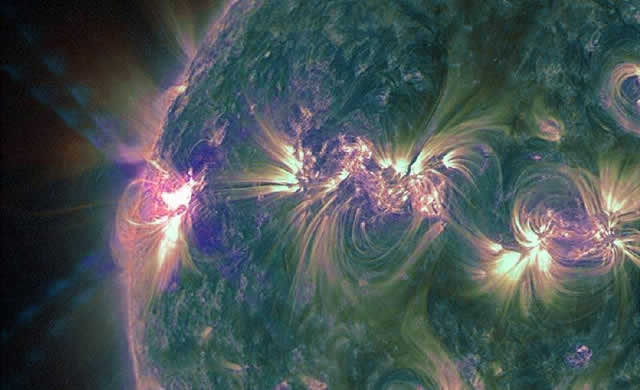
CREDIT: NASA/SDO
Il cosiddetto maltempo spaziale, ovvero ciò che riguarda una attività solare estrema, potrebbe essere devastante per il nostro pianeta come gravi tornado e altre calamità naturali, ha detto il capo della NASA Charles Bolden in un discorso pubblico, lo scorso 4 Giugno.
Bolden ha parlato prima degli scienziati e degli addetti ai lavori del settore presso lo Space Weather Enterprise Forum, che si è tenuto presso la National Oceanic and Atmospheric Administration Auditorium e Science Center di Silver Spring, nel Maryland. La conferenza mirava a riunire ricercatori e responsabili politici per individuare in che modo l’attività del sole impatti la Terra, e gli effetti potenzialmente nocivi della meteorologia spaziale.
“Questa conferenza punta i riflettori su un altro fenomeno naturale che può essere altrettanto distruttivo al pari un tornado: la meteorologia spaziale”, Bolden ha detto nelle sue osservazioni scritte per l’evento, dopo aver menzionato il suo dolore per le vite perse per il tornado verificatosi nel Midwest nelle ultime settimane. Forti tempeste solari possono danneggiare i satelliti nello spazio e, se rivolte verso la terra, possono interferire con le infrastrutture di comunicazione e con le reti elettriche a terra. I partecipanti alla conferenza hanno discusso sui potenziali e sulla vulnerabilità nelle infrastrutture esistenti, e di come possono essere potenziate e rese più robuste. I ricercatori che si occupano di studiare il sole attraverso la meteorologia spaziale hanno anche evidenziato gli sforzi di mitigazione in corso, compresi i miglioramenti nella tecnologia e dei modelli che possono aiutare a prevedere le tempeste future. Lo sviluppo di un quadro più chiaro di quando queste tempeste solari possono colpire, e il loro potenziale impatto, è di fondamentale importanza, ha ribadito Bolden.
Severe space weather could be as devastating to the planet as serious tornadoes and other natural disasters, NASA chief Charles Bolden said in a public address Tuesday (June 4).
Bolden spoke before scientists and industry members at the Space Weather Enterprise Forum, which was held at the National Oceanic and Atmospheric Administration Auditorium and Science Center in Silver Spring, Md. The daylong conference aimed to bring together researchers and policymakers to identify how the sun’s activity impacts Earth, and the potentially harmful effects of space weather.
“This conference shines a spotlight on another naturally occurring phenomenon that can be just as punishing as a tornado — space weather,” Bolden said in his written remarks for the event, after mentioning his grief at the lives lost during the deadly outbreak of tornadoes in the Midwest in recent weeks. Strong solar storms can damage satellites in space and, if aimed at Earth, can interfere with communications infrastructure and power grids on the ground. Conference attendees discussed potential vulnerabilities in existing infrastructure, and how they can be made more robust. Space weather researchers also highlighted ongoing mitigation efforts, including improvements in technology and modeling that may help predict future storms. [Photos: Inside NASA’s Space Weather Tracking Center] Developing a clearer picture of when these storms may strike, and their potential impacts, is crucial, Bolden said.
Source/Continue reading → SPACE.com

















